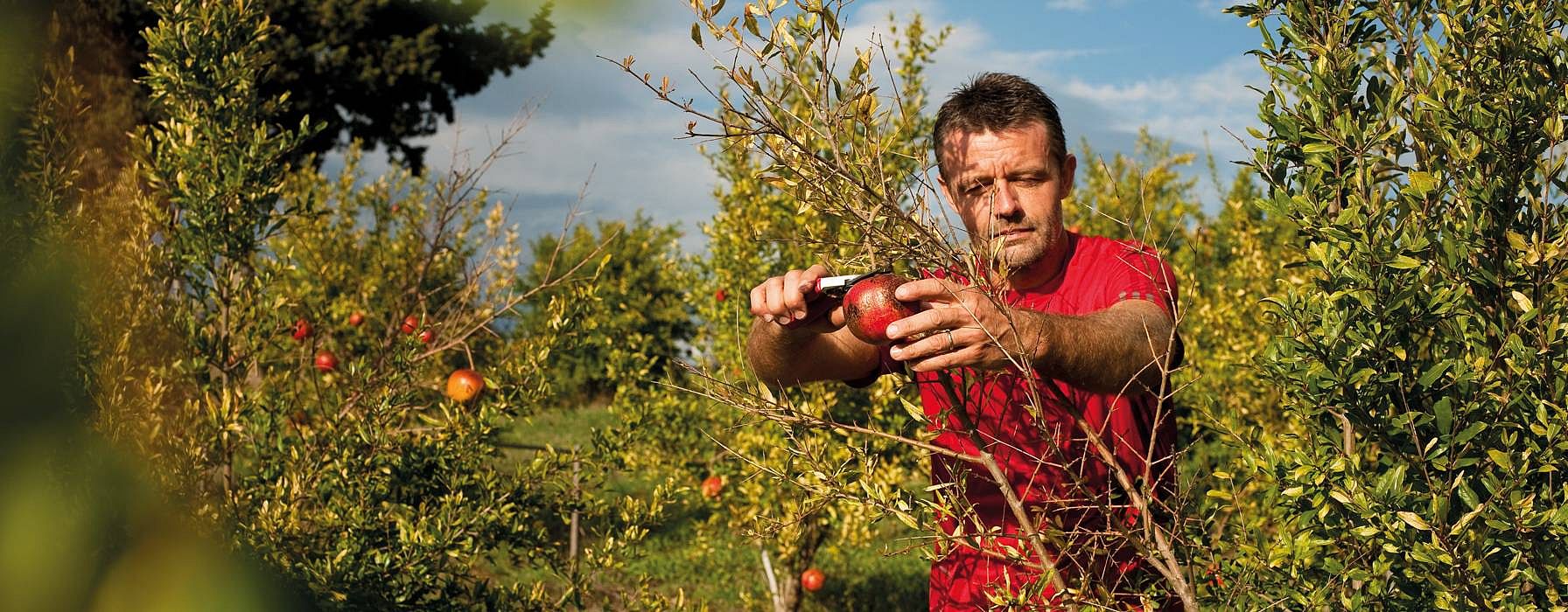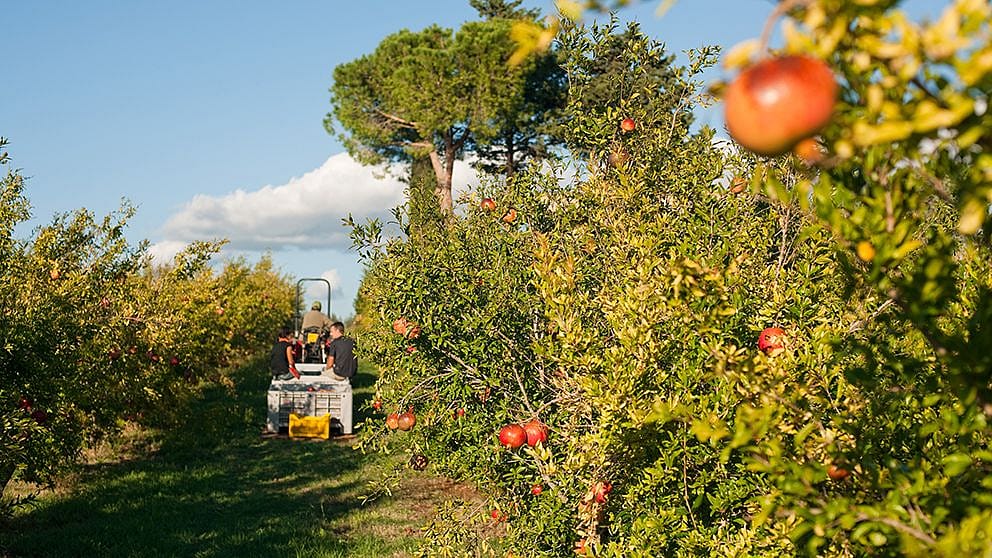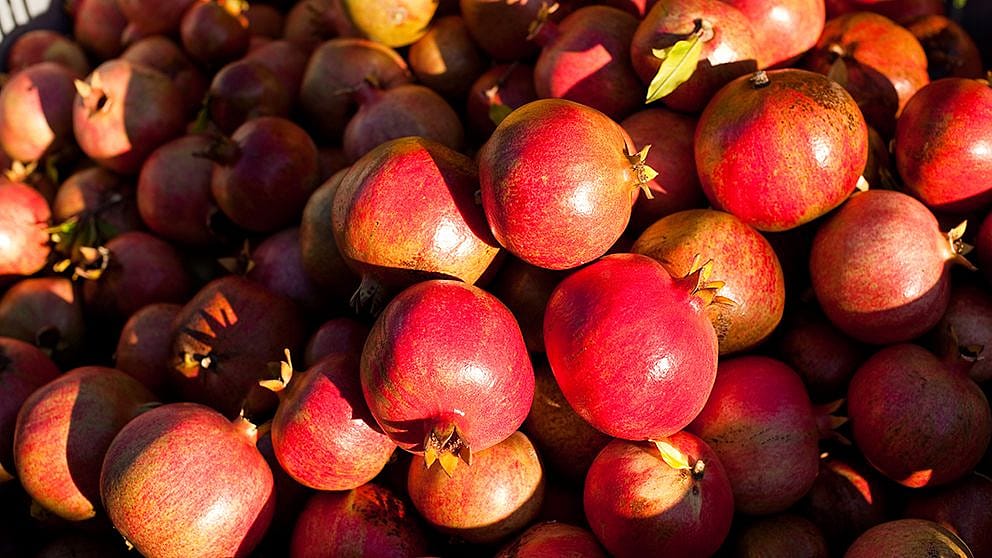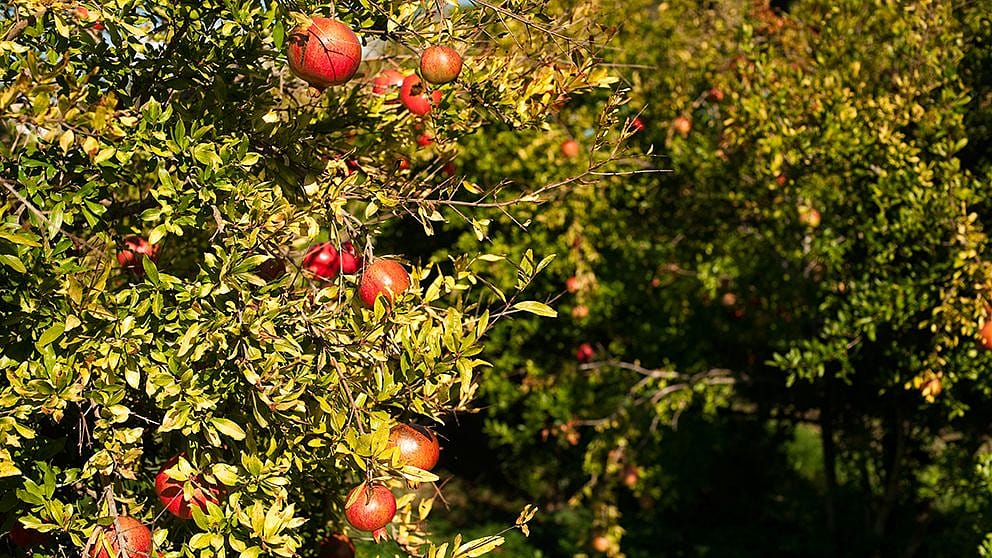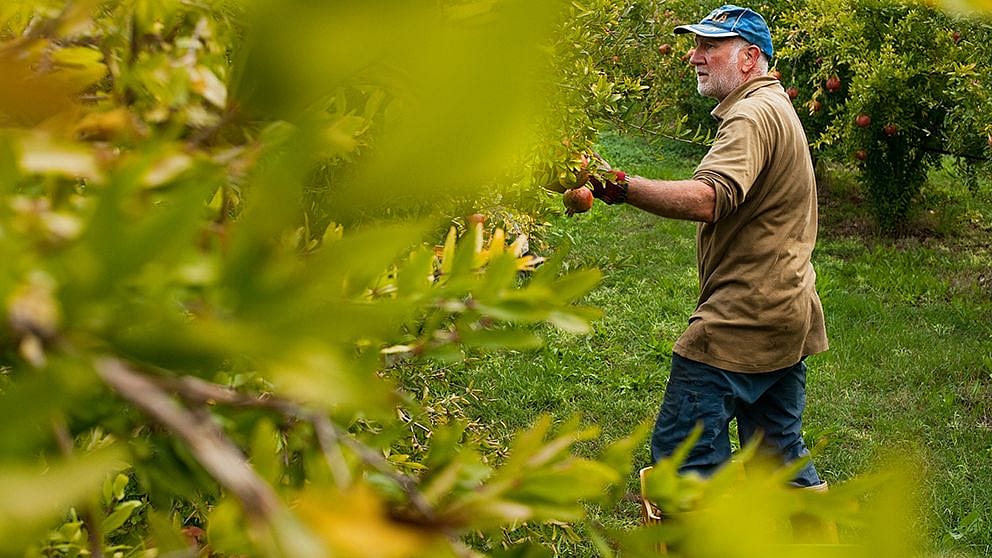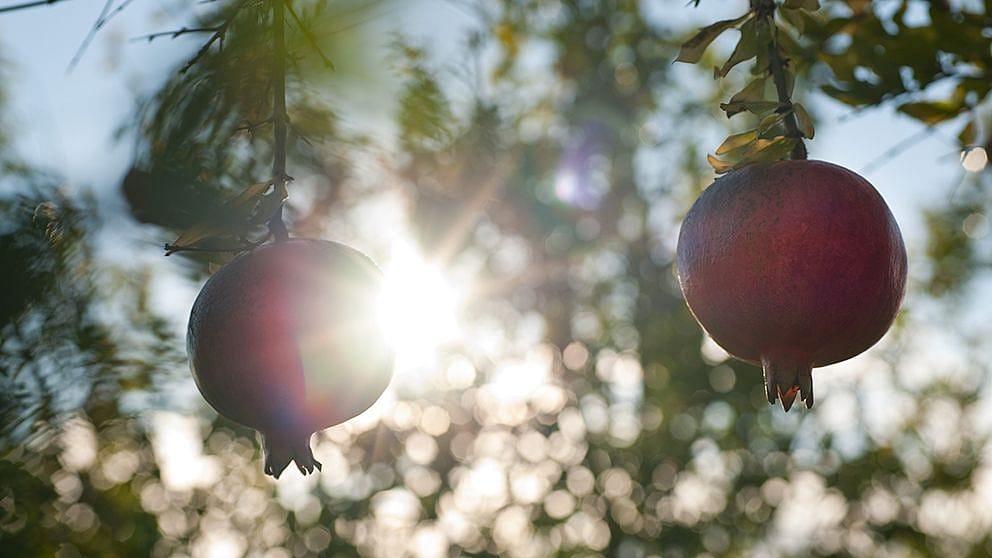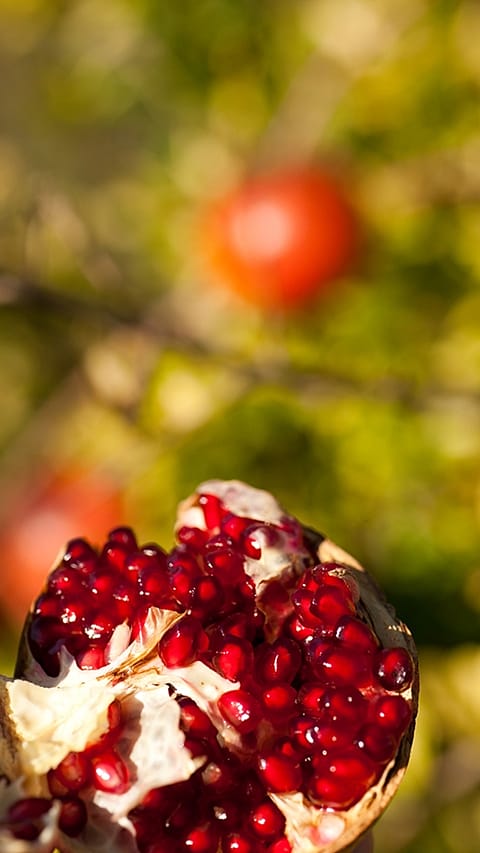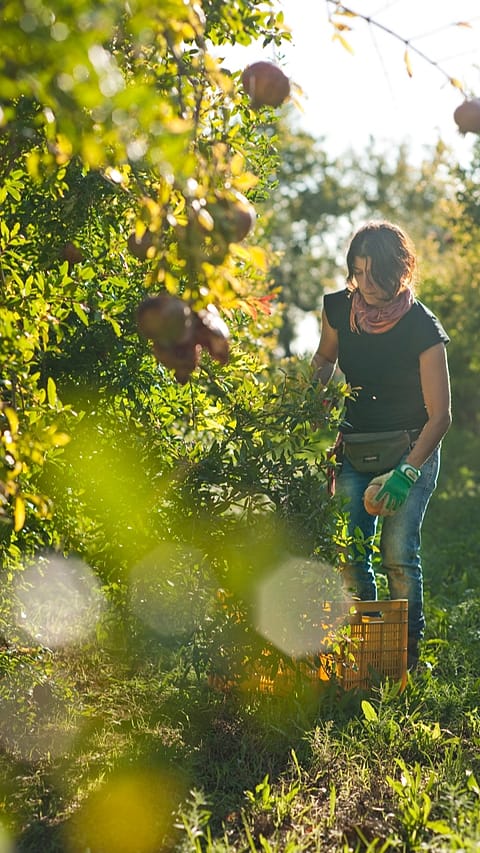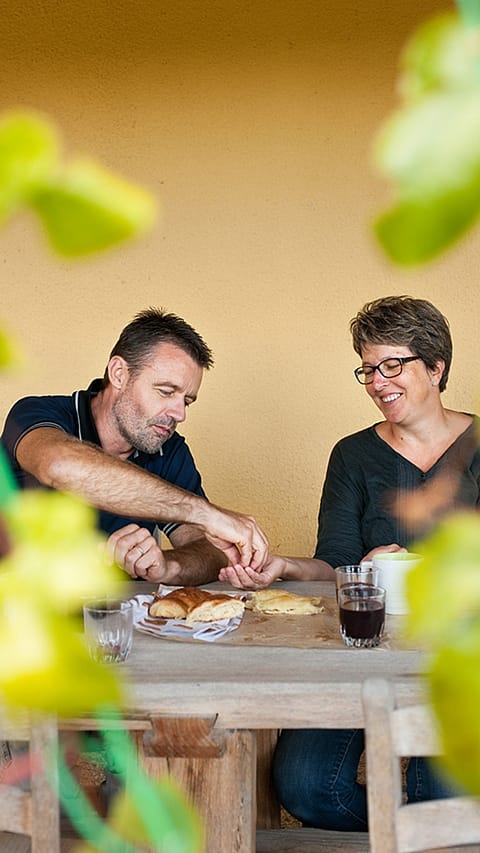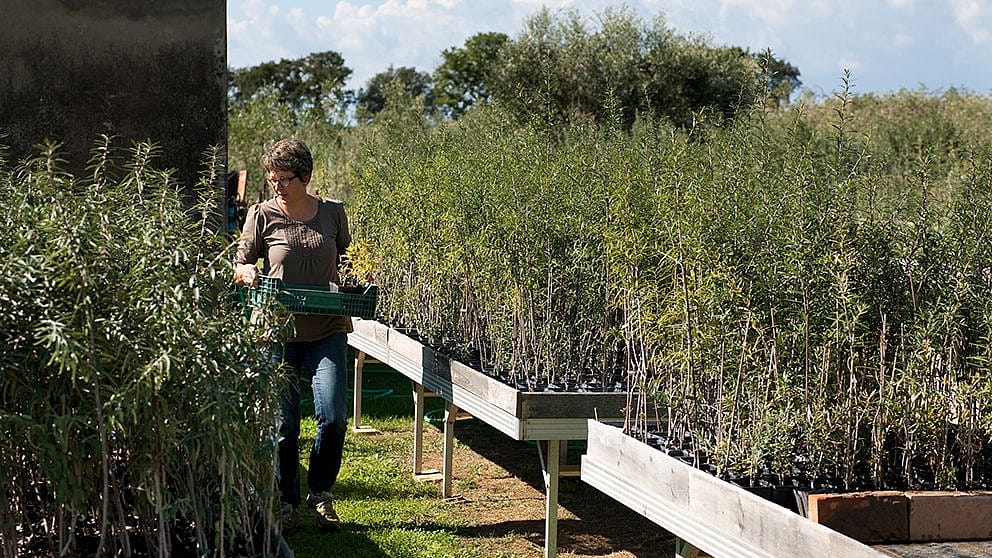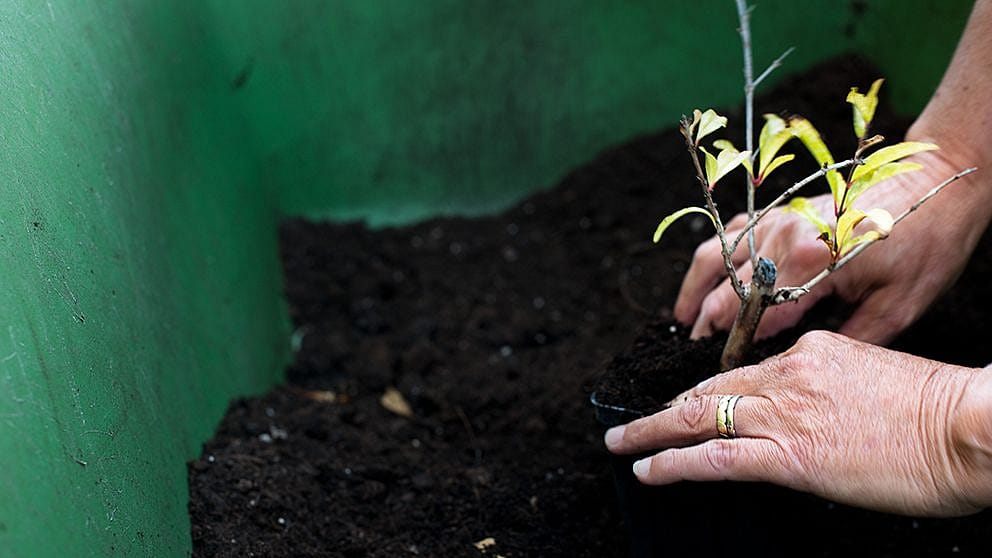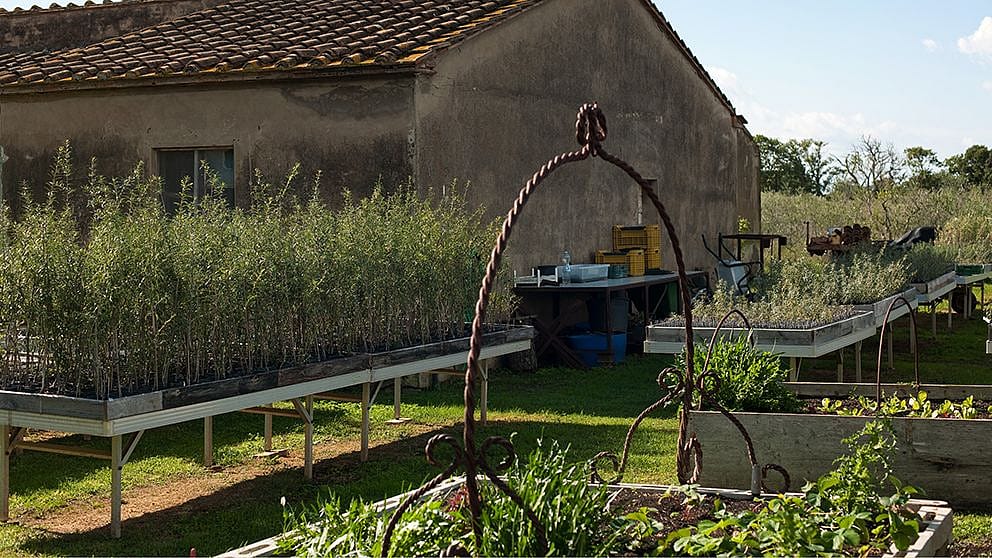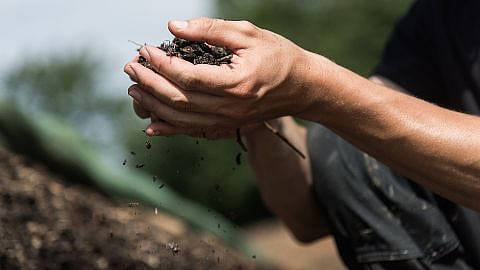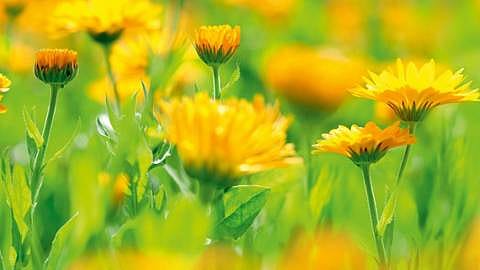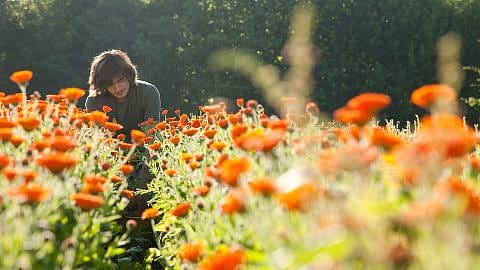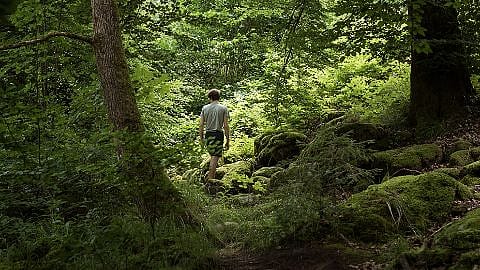Unde crește frumusețea
Între munți și mare, în provincia italiană Livorno, Toscana, predomină un microclimat unic. Aici, la o fermă, rodiile sunt cultivate și procesate pentru sucul lor bogat în nutrienți. Pentru cei implicați, recolta de rodii oferă motiv de sărbătoare.
Cerul este senin și albastru, iar orice ar fi putut împiedica anterior acest lucru a fost acum măturat de vântul care sufla de pe coasta etruscă din apropiere. Ca în fiecare dimineață, SUV-ul lui Fredy Röthlisberger oprește la conacul Bellavista, vopsit în galben strălucitor. Amplasat în mijlocul unei suprafețe vaste, acesta este sediul administrativ al Azienda Agricola San Mario, o proprietate certificată Demeter. O potecă de pietriș mărginită de pini se află drept în față, concepută pentru a ne capta și a ne îndrepta atenția.
Dar când vizitează Bellavista în zilele de toamnă ca aceasta, notează Fredy, acest aspect de design al conacului toscan pur și simplu nu pare să funcționeze. Inevitabil, atenția noastră se îndepărtează de pini și conac – spre stânga, dincolo de arbuștii tineri de cătină și se așează pe șirurile de plante care strălucesc roșu aprins din mijlocul lor. Sau mai exact: cel mai frumos, roșu rodie.
Arbuștii de rodie sunt plantați în rânduri lungi, distanțate la 5 metri unul de celălalt și extinzându-se până la 150 de metri lungime. Pentru directorul fermei, este întotdeauna un sentiment minunat să te plimbi între ei și să te bucuri de fructele roșii strălucitoare pentru el însuși. Pe măsură ce sfârșitul verii se apropie, culorile și formele acestui cornu abundent luxuriant nu încetează să-l uimească. Până la 50 de rodii atârnă ca niște felinare pe fiecare arbust, abia la fel de înalte ca o persoană adultă. Și de parcă aspectul lor general nu ar fi suficient de impresionant, în partea de jos a fiecărui fruct se află o stea mică, formată din sepalele bobocului floral. Ramurile se îndoaie jos sub sarcina lor grea, unele dintre ele ating pământul. Dar se apropie relief pentru ramurile vizibil încordate, așa cum sugerează sunetul plin de viață al vocilor aflate la doar câteva rânduri înainte.
Culegerea lor acum le-ar nega ultimele lor raze de soare energizante?
Fredy Röthlisberger
Imediat, la șapte și jumătate dimineața, muncitorii încep cu recoltarea. „Momentul este critic”, spune Fredy, care poartă pantofi de trekking și o barbă de trei zile, în timp ce își cercetează grădina toscană cu familiaritatea unui urbanist care cunoaște fiecare colț al balconului bucătăriei ei. În urmă cu două săptămâni, cicadele încă mai susțineau cu nerăbdare concertele chiar înainte în plantația de măslini. Dar apoi, dintr-o dată, a devenit tăcut la ferma Bellavista – cel puțin în exterior. Fredy spune că se simte ca și cum stă pe „ace” în această perioadă de tranziție, după ce cătina a fost recoltată și înainte ca măslinele să fie presate. Merge zilnic de-a lungul rândurilor de rodii, întorcând fructele pentru a le evalua mai bine. Au atins deja maturitatea deplină? Amenință să se deschidă, ar trebui să mai fie o noapte rece? Alegerea lor acum le-ar nega ultimele lor raze de soare energizante? Uneori muncitorii trebuie să lase totul să cadă, când timpul este copt. Poate depinde de câteva ore, spune Fredy. Iar pulpa fructului, care învăluie protector semințele nutritive, ar trebui să fie de preferință roșu intens – „Este prea devreme dacă este roz”, spune el. În plus, dacă fructul s-a despicat deja, acesta trebuie procesat imediat, pentru a păstra cât mai mult din nutrienții săi benefici.
Fredy și personalul său folosesc o pompă manuală hidraulică pentru a procesa rodiile - este cea mai blândă metodă care există. Este, de asemenea, destul de consumator de timp și ar dura mult prea mult dacă recolta ar trebui procesată dintr-o dată. Însă pe holurile din spatele conacului galben, angajații sunt ocupați din toamnă până la Crăciun cu procesarea rodiei, până nu mai sunt fructe – doar suc.
În această dimineață, Fredy este vizibil relaxat: ca și în ultimii ani, momentul a fost perfect. Din nou și din nou, pune mâna în coșurile de pe podea, ia un fruct și îl deschide cu grijă. Dă din cap și spune că exact așa ar trebui să fie fructele coapte la soare.
Lucrătorii de la fermă sunt și ei îndrăgiți: pentru Marcella Pagliara, culesul de rodii de pe copaci este o sarcină frumoasă și plină de satisfacții. „Bello” – cuvântul italian pentru „frumoasă” scapă în mod repetat de buzele italiancei slăbite, cu vocea râpoasă și melodică. Ea subliniază că nu se referă doar la frumusețea fructelor, ci și la activitatea de recoltare. Într-adevăr, mișcările Marcellei sunt aproape de dans, în timp ce manevrează în jurul tufelor cu fructe. Își poziționează cu grijă foarfecele de tăiere înainte de a le închide, apoi pune ușor încă o sferă roșie în coșul ei de recoltare.
Parcă fiecare fruct vrea să fie apreciat pentru ultima dată, înainte de a părăsi grădina. De parcă ar trebui să existe un scurt moment de recunoștință și tăcere.
Cu mișcări fluide, grupul vesel de culegători progresează metru cu metru. Nu există niciun semn de stres sau plictiseală - poate pentru că mărimea fructului face imposibil să luați mai mult de unul în mână odată. Cu fiecare fruct, trebuie să începem mereu din nou: îndoiți și observați cu atenție înainte de a culege în cele din urmă. Parcă fiecare fruct vrea să fie apreciat pentru ultima dată, înainte de a părăsi grădina pentru presa de suc. De parcă ar trebui să existe un scurt moment de recunoștință și tăcere.
Printre muncitori se numără un antrenor de cai, un fierar și un fost inginer, care s-a săturat de cariera anterioară și acum se simte mai întemeiat prin noile sale responsabilități la fermă. Fredy explică că nu își dorea muncitori complet necalificați, ci mai degrabă oameni care au un ochi pentru natură.
Apoi o altă încărcătură este plină. Remorca, care seamănă mai mult cu o placă de metal trasă de lanțuri, alunecă pe iarbă fără a lăsa urme. Fredy a proiectat el însuși structura neconvențională: cu cât solul este mai intact și mai bogat în minerale, cu atât plantele care cresc în el sunt mai bine îngrijite. Fredy se asigură că plantele primesc doar ce e mai bun, astfel încât să poată prospera aici de-a lungul coastei, la sud-vest de orașul Pisa.
Rodia este ca un copil ușor de îngrijit și pur și simplu o bucurie
Fredy Röthlisberger
Această regiune este renumită pentru microclimatul său unic – creat în parte de lanțul muntos Apenini, care devine vizibil de la câțiva kilometri mai în interior. Vânturile care sufla din Marea Ligurică se opresc când ajung la munți, apoi se întorc și traversează regiunea a doua oară. Rezultatul este o combinație ideală de soare, căldură și vânt pe care cunoscătorii de vinuri o consideră responsabilă pentru calitatea excelentă a numeroaselor vinuri locale de renume mondial. Această combinație favorabilă de elemente naturale pare să beneficieze și rodia.
„Rodia este ca un copil ușor de îngrijit și pur și simplu o bucurie”, gândește Fredy. Timp de două veri consecutive, măslinii au fost afectați de musca măslinului, iar o furtună de grindină i-a distrus odată o parte din recolta lui de cătină. Tufele de rodie, pe de altă parte, își arată în mod constant roșul strălucitor la începutul toamnei, chiar dacă înghețurile nocturne predomină, când primele frunze încep să încolțească în aprilie.
Fructul a căzut de mult în obscuritate în regiune – în ciuda faptului că era originar din Italia. Tufișuri izolate ar putea fi întrezărite în grădinile din față sau cresc pe marginea drumului. Oamenii parcă nu mai știau ce să facă cu rodiile, decât să le așeze în pervaz de Crăciun sau să le includă în buchetele de mireasă ca simbol al fertilităţii. Până acum opt ani, adică atunci când Kurt Künzi, socrul lui Fredy acum decedat și un elvețian ca el, a decis să cultive rodie pentru sucul său fortificator pentru sănătate. El făcuse același lucru cu cătină când și-a înființat ferma la sfârșitul anilor 1980.
Astăzi, succesorul său consideră că este important să-și amintească obiectivul fondator al fermei Bellavista și al proprietății principale, San Mario, la doar trei kilometri distanță: să ofere oamenilor substanțe benefice care întăresc sistemul imunitar. Uneori este aproape uluitor când se uită la rândurile de plante. O sută de hectare de vitamine, crede el. Bellavista vinde direct localnicilor, care vin regulat. Oamenii au spus că sucul a îmbunătățit abilitățile de concentrare ale copiilor lor și că a ferit familia de curgerea nasului. Femeile au spus că a făcut efectele menopauzei mai tolerabile.
Rodia și cătina sunt produse de San Mario ca suc direct (nu din concentrat); compania produce și cătină sub formă de sirop. O parte din sucul de rodie este folosit în produse de îngrijire a pielii de înaltă calitate. Și ajunge, de asemenea, în bucătăria multor angajați ai fermei.
Înainte ca producția de suc de rodie să fie lansată oficial în urmă cu trei ani, a existat o fază de testare de cinci ani. Au fost luate în considerare diferite metode de irigare și locații de cultivare și au fost multe experimente cu primele recolte mici. În bucătărie, de exemplu: Irene Siegrist, care lucrează în biroul de la Bellavista, se bucură de felul în care rodiile face sosurile de carne minunat de netede și bine colorate. Și din semințele de rodie pe care continuă să le folosească în loc de stafide în brioșele ei.
Puterea Soarelui într-un pahar
Până acum este prânzul și timpul pentru o pauză. Ca în fiecare zi, Fredy se întoarce cu mașina prin câmpuri până la conacul de la ferma San Mario, situată la doar câțiva kilometri. Aici clădirea este, de asemenea, vopsită în galben strălucitor, cu teren agricol de jur împrejur. Martina, soția lui Fredy, așteaptă pe verandă, înconjurată de florile pasiunii înflorite. La prânz există curcan cu morcovi și salată. Martina Künzi comentează că sunt oameni cu picioarele pe pământ, cei care nu au nevoie de o alee de acces spre casa lor. Dar cu siguranță se pot avea standarde înalte când vine vorba de ceea ce bem, adaugă soțul ei cu ochiul, în timp ce așează o carafa de sticlă pe masa de stejar. Numai culoarea amestecului de suc de cătină-rodie din el este fascinantă. Cum poate fi descris - ca roșu-foc sau violet-portocaliu? „Să spunem că Fredy a pus vara pe masă”, spune Martina și așa este. Puterea soarelui se află în interiorul acestui vas de sticlă și de până la 20 de ori mai multă vitamina C decât în sucul de portocale, spune Fredy. Este ceva ce ar trebui să știe, pentru că l-a analizat el însuși, lucru pe care îl face în mod regulat la laboratorul intern al Bellavista.
Căzi de mistreți
În timp ce Fredy face naveta regulat între ambele ferme, Martina rămâne în principal la San Mario. La șase dimineața, după ce a închis fereastra dormitorului pentru a feri de căldură, Martina ia în calcul munca care ne așteaptă: 20.000 de plante tinere, repartizate pe 70 de mese de plantat. Îngrijirea pepinierei necesită numeroase ore de muncă – plantare, transplantare, plivire și udare – Martina ar evita mai degrabă să-și asume mai multă muncă decât atât, recunoaște ea. Apoi ea subliniază o altă priveliște interesantă: lângă rodii sunt șanțuri mari de mărimea căzilor, umplute cu apă de ploaie.
Mistreții au săpat acele șanțuri și la început au fost umplute din nou, aproape zilnic. Acest lucru a făcut ca animalele să sape șanțuri noi și chiar mai mari în cursul nopții următoare. În cele din urmă, au lăsat pur și simplu șanțurile în pace – la fel și mistreții. Acum au mai rămas doar câteva astfel de șanțuri. Construirea unui gard ar fi fost contrară principiului biodinamic, care vede natura ca pe ceva continuu, explică Martina. Câmpurile din San Mario sunt înconjurate în mod natural de garduri vii și mici plantații de stejari, care oferă adăpost unei abundențe de păsări diferite. Bufnița, chiriașul cu spate roșu și un mare inventar de fazani se numără printre cei care trăiesc aici.
O viziune devine realitate
Uneori, Martina, în vârstă de 49 de ani, se gândește la cum a început totul. Cum, în copilărie, a vizitat Italia împreună cu părinții ei în vacanță și cum și-a dorit tatăl ei să trăiască visul toscan. Dar nu în sensul de a da înapoi și de a pune costumul de baie. În schimb, a lui a fost dorința de a cunoaște peisajul unic și natural al regiunii, de a experimenta satele și de a culege ierburi. Astăzi, Martina duce mai departe visul tatălui ei. Și face asta de mult cu Fredy, care la 22 de ani a început să-l însoțească pe tatăl iubitei lui de atunci în colțuri îndepărtate ale Elveției în căutarea cătinii sălbatice pentru cultivare. Ei au căutat în climate în care plantele cresc cel mai bine și în care oamenii par să înțeleagă că fac parte din cosmos, unde viața înseamnă mai mult decât consumatoare, ci despre lucru și să-și facă timp pentru a se opri și a fi uimiți. Unde această uimire vine cel târziu în toamnă, când rodia atrage atenția.
